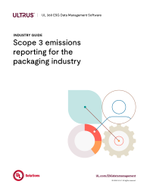
Scope 3 reporting for the packaging industry
Discover the challenges, opportunities and first steps that packaging companies must consider when working to calculate, report and reduce their scope 3 greenhouse gas (GHG) emissions.

Due to packaging’s enormous environmental impact, the packaging industry faces mounting pressure to run more sustainable business operations and report sustainability data, including progress toward greenhouse gas (GHG) emissions reduction targets.
Until recently, companies have focused on reporting scope 1 emissions — direct emissions from sources that a company owns or controls — and scope 2 emissions — indirect emissions from the off-site generation of electricity, steam, heating and cooling bought and consumed by the company. However, in recent years, a greater emphasis has been placed on scope 3 emissions reporting, which includes all other indirect emissions occurring in a company’s value chain and comprises the majority of the packaging industry’s emissions. Despite demand for enhanced emissions reporting, only a small minority of packaging companies have set public commitments to reducing scope 3 emissions, due in part to several features of the packaging industry that complicate scope 3 emissions calculation, reporting and reduction.
UL Solutions’ experts are here to help. Read our guide to increase your understanding of the challenges, opportunities and first steps packaging companies must consider as they embark on their scope 3 emissions reporting journey.

Scope 3 reporting for the packaging industry
Thanks for your interest in our products and services. Let's collect some information so we can connect you with the right person.